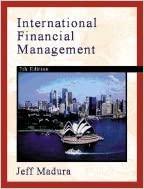Answered step by step
Verified Expert Solution
Question
1 Approved Answer
QUESTION 1 If you invest $ 1 0 0 at 1 2 percent for four years, how much would you have at the end of
QUESTION
If you invest $ at percent for four years, how much would you have at the end of four years using compound interest?
A $
B
C $
D $
QUESTION
An initial investment of $ produces a cash flow of $ one year from today. Calculate the rate of return on the project.
A percent
B percent
C percent
D percent
QUESTION
Mr Hopper expects to retire in years, and he wishes to accumulate $ in his retirement fund by that time. If the interest rate is percent per year, how much should Mr Hopper put into his retirement fund at the end of each year in order to achieve this goal?
A $
B $
C $
D $
QUESTION
Present value is defined as
A future cash flows discounted to the present by an appropriate discount rate.
B future cash flows multiplied by the factor rt
C inverse of future cash flows.
D present cash flows compounded into the future.
QUESTION
If we invest $ in a bank savings account where it will earn a nominal rate of percent per year, compounded semiannually, how much will it be worth at the end of years? Round off the answer to the nearest cent.
Answer
QUESTION
An investment at percent APR compounded monthly is equal to an effective annual rate of
A percent.
B percent.
C percent.
D percent.
QUESTION
The concept of compound interest is best described as
A the inverse of simple interest.
B interest earned on an investment.
C the total amount of interest earned over the life of an investment.
D interest earned on interest.
QUESTION
A dollar today is worth more than a dollar tomorrow if the interest rate is positive.
True
False
QUESTION
An asset that pays a fixed amount each period for a specified number of periods is an annuity.
True
False
QUESTION
A perpetuity is defined as a sequence of
A unequal cash flows occurring at equal intervals of time forever.
B equal cash flows occurring at equal intervals of time forever.
C unequal cash flows occurring at equal intervals of time for a specific number of periods.
D equal cash flows occurring at equal intervals of time for a specific number of periods.
QUESTION
The present value of $ expected at the end of one year, at a discount rate of percent per year, is
A
B
C
D
QUESTION
What is the present value of $ per year in perpetuity at an annual interest rate of percent? Assume the perpetuity starts in one year.
A $
B $
C $
D $
QUESTION
What is the present value of a $ per year annuity for five years at an interest rate of percent?
A
B
C
D
QUESTION
For $ you can purchase a fiveyear annuity that will pay $ per year for five years. The payments occur at the beginning of each year. Calculate the effective annual interest rate implied by this arrangement.
A percent
B percent
C percent
D percent
QUESTION
Mr Williams expects to retire in years and would like to accumulate $ million in his pension fund. If the annual interest rate is percent, how much should Mr Williams put into his pension fund each month in order to achieve his goal? Assume that Mr Williams will deposit the same amount each month into his pension fund, using monthly compounding.
A
B
C
D
QUESTION
John House has taken a $ mortgage on his house at an interest rate of percent per year. If the mortgage calls for equal annual payments, what is the amount of each payment?
A
B
C
D
QUESTION
You would like to have enough money saved after your retirement such that you and your heirs can receive $ per year in perpetuity. How much would you need to have saved at the time of your retirement in order to achieve this goal? Assume that the perpetuity payments start one year after the date of your retirement. The annual interest rate is percent.
A $
B $
C $
D $
QUESTION
After retirement, you expect to live for years. You would like to have $ income each year. How much should you have saved in your retirement account to receive this income, if the annual interest rate is percent per year? Assume that the payments start on the day of your retirement.
A $
B $
C $
D $
QUESTION
You just inherited a trust that will pay you $ per year in perpetuity. However, the first payment will not occur for exactly five more years. Assuming an percent annual interest rate, what is the value of this trust?
A $
B $
C
Step by Step Solution
There are 3 Steps involved in it
Step: 1

Get Instant Access to Expert-Tailored Solutions
See step-by-step solutions with expert insights and AI powered tools for academic success
Step: 2

Step: 3

Ace Your Homework with AI
Get the answers you need in no time with our AI-driven, step-by-step assistance
Get Started


